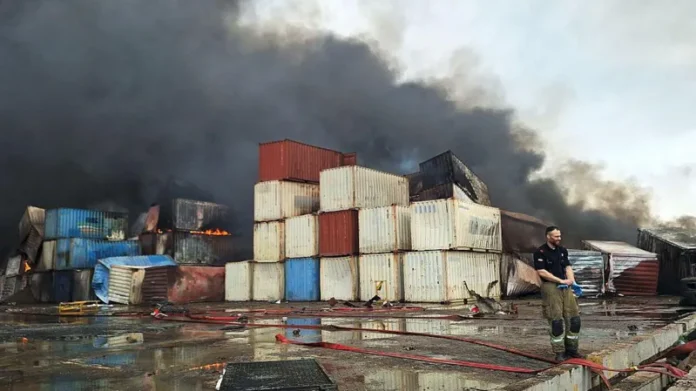A deadly explosion at Shahid Rajaee port in southern Iran has claimed the lives of at least 40 people, with more than 1,000 others injured.
The blast, which occurred on Saturday morning, has sent shockwaves across the country, sparking widespread mourning and anger.
The explosion was so powerful that it caused fires to blaze throughout the port area, with thick black clouds of toxic chemicals lingering over the surrounding region.
Authorities have urged residents in nearby towns and cities to stay indoors and wear protective clothing as a precaution against the toxic smoke.
In Bandar Abbas, a city located just a short distance from the port and home to the Iranian Navy’s main base, all schools and government offices were shut down on Sunday to allow authorities to focus on the ongoing emergency response.
The explosion occurred in the early hours of the morning when the port, which serves as one of Iran’s largest commercial hubs, was bustling with activity.
Despite the devastating nature of the incident, many Iranians have come forward to offer help. Across the country, people rushed to local hospitals to donate blood, as the number of casualties quickly mounted.
By Sunday evening, the fires at the port were still raging, and authorities were working to contain the damage.
A local festival scheduled to take place near the port turned from a celebration into a somber memorial, with citizens coming together to remember the dead and pray for those still fighting for their lives.
On Sunday, Iran’s government declared a day of national mourning, with an additional two days of mourning announced in Hormozgan province, where the port is located.
While the immediate physical devastation is apparent, the explosion has also fueled a growing sense of frustration and confusion across Iran.
The cause of the blast is under intense scrutiny, with some questioning whether the explosion was linked to the military’s activities at the port.
Ambrey Intelligence, a private maritime risk consultancy, suggested that the explosion may have been caused by improper handling of a shipment of solid fuel intended for use in Iran’s ballistic missiles.
According to the firm, fires seen spreading between containers before the explosion likely involved a shipment of sodium perchlorate, a key ingredient used in solid rocket fuel.
An anonymous source cited by The New York Times, with connections to Iran’s Islamic Revolutionary Guard Corps (IRGC), also claimed that the explosion involved sodium perchlorate.
However, the Iranian military has denied these allegations, with a spokesman for the army rejecting the claim that the port was storing rocket fuel.
Social media speculation has also fueled a conspiracy theory suggesting that Iran’s military and the IRGC were storing recently imported rocket fuel from China at the port.
While this claim has not been substantiated, it has nevertheless ignited tensions and raised questions about transparency from the Iranian authorities.
As Iran grapples with the aftermath of the explosion, questions surrounding the true cause of the tragedy remain unresolved.
The blast, which has caused immense human suffering and widespread property damage, has also intensified the ongoing political debate about the military’s influence on the country’s civilian infrastructure.
As the investigation continues, many Iranians are left searching for answers amidst the grief and anger that has swept across the nation.

